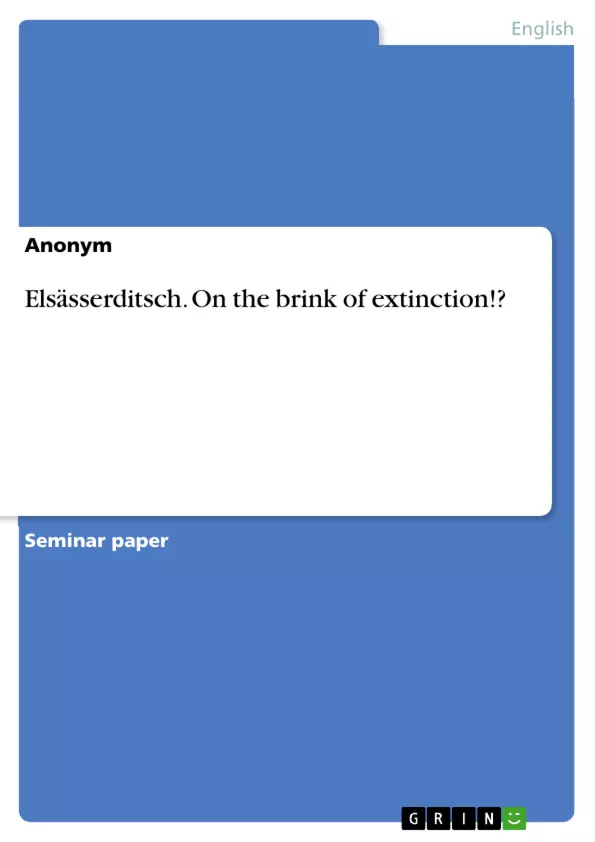There is a contemporary caricature, that describes the problem of an own language between Germany and France fairly good. On a roof, there are the French Cockerel, the Alsatian Stork in the middle and the German Eagle. Both the French and the German bird are attempting to make the stork speak their language. After the stork struggles to speak these languages, the neighbours become impatient and louder. The Alsatian bird finally cries: ‘Mir langst jetz mit ejch zwei, nundediawle! Ich redd wie mir de Schnawel gewachse isch!’
Situated at the French border to Germany, the Alsace is a region where also the linguistic border in between German and French can be found. As it used to belong to both Germany and France at certain points in its history, an interesting situation of language use and contact has evolved over the last centuries. In France its 1.8 million inhabitants are often referred to as Germans, even though it is part of France and in spite of the fact, that the official language is French since Alsace-Lorraine has been handed back to France after World War 2. Nevertheless an Upper German dialect called Alsatian (Elsässerditsch) is still spoken there.
Inhaltsverzeichnis (Table of Contents)
- Introduction
- The linguistic situation in Alsace with a historical perspective
- Theory
- Language Contact
- Code-switching
- Code-switching in Alsace
- Conclusion
- References
Zielsetzung und Themenschwerpunkte (Objectives and Key Themes)
The main objective of this term paper is to analyze the future prospects of the Alsatian dialect. This is achieved by examining the phenomenon of Code-switching in everyday situations and its implications for the language's vitality. The paper will explore the historical and sociolinguistic context of Alsace, providing a detailed analysis of the linguistic situation in the region.
- The historical development of Alsace and its impact on the linguistic landscape.
- The role of language contact and Code-switching in the maintenance and decline of minority languages.
- The sociolinguistic factors that influence the use of Alsatian in contemporary Alsace.
- The implications of Code-switching for the future of the Alsatian dialect.
Zusammenfassung der Kapitel (Chapter Summaries)
The introduction provides a humorous and insightful overview of the linguistic situation in Alsace. It highlights the tension between French and German influences on the Alsatian dialect and introduces the central focus of the term paper: the future of the Alsatian dialect in the context of Code-switching.
The chapter 'The linguistic situation in Alsace with a historical perspective' examines the historical development of Alsace and its linguistic landscape. It discusses the annexation of Alsace to France and its impact on the use of Alsatian. The chapter also explores the influence of social and economic factors on the decline of Alsatian, highlighting the role of education and the preference for French as a symbol of cultural consciousness.
The 'Theory' chapter delves into the concept of Language contact, explaining how languages and dialects interact in multilingual communities. It then introduces the phenomenon of Code-switching, describing its characteristics and the various perspectives on its significance and function in language contact situations.
Schlüsselwörter (Keywords)
This term paper focuses on the crucial themes of language contact, Code-switching, language vitality, and sociolinguistic factors in the context of the Alsatian dialect. The research delves into the historical and political development of Alsace, the linguistic situation in the region, and the implications of Code-switching for the future of the Alsatian dialect.
- Quote paper
- Anonym (Author), 2013, Elsässerditsch. On the brink of extinction!?, Munich, GRIN Verlag, https://www.grin.com/document/267373



